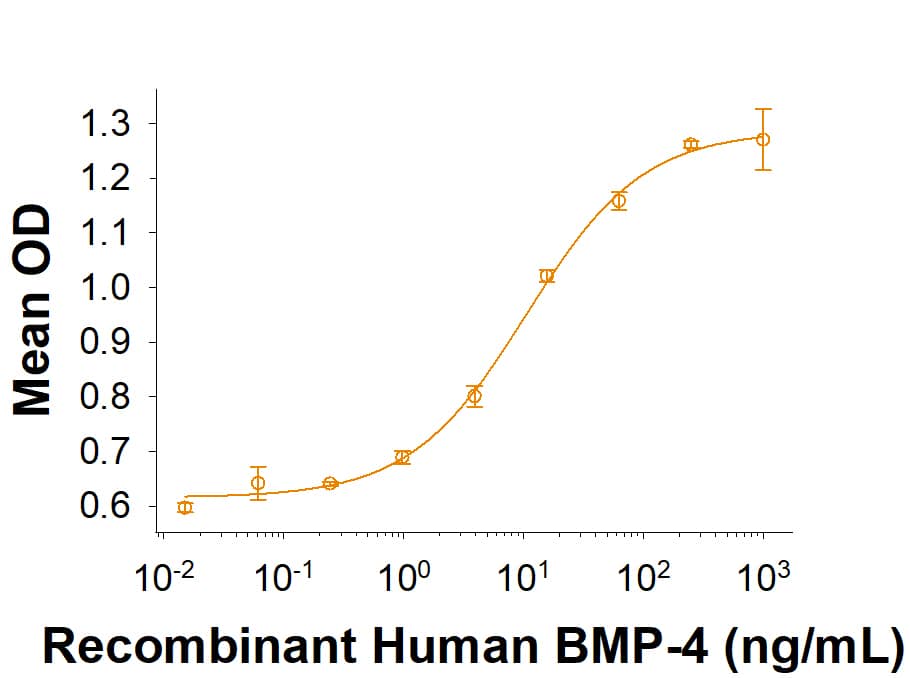Recombinant Human Artemin Protein Summary
Product Specifications
Ala108-Gly220
Analysis
Customers also Viewed
Product Datasheets
Carrier Free
CF stands for Carrier Free (CF). We typically add Bovine Serum Albumin (BSA) as a carrier protein to our recombinant proteins. Adding a carrier protein enhances protein stability, increases shelf-life, and allows the recombinant protein to be stored at a more dilute concentration. The carrier free version does not contain BSA.
In general, we advise purchasing the recombinant protein with BSA for use in cell or tissue culture, or as an ELISA standard. In contrast, the carrier free protein is recommended for applications, in which the presence of BSA could interfere.
2589-AR
| Formulation | Lyophilized from a 0.2 μm filtered solution in HCl with BSA as a carrier protein. |
| Reconstitution | Reconstitute at 100 μg/mL in sterile 4 mM HCI containing at least 0.1% human or bovine serum albumin. |
| Shipping | The product is shipped at ambient temperature. Upon receipt, store it immediately at the temperature recommended below. |
| Stability & Storage: | Use a manual defrost freezer and avoid repeated freeze-thaw cycles.
|
2589-AR/CF
| Formulation | Lyophilized from a 0.2 μm filtered solution in HCl. |
| Reconstitution | Reconstitute at 100 μg/mL in sterile 4 mM HCl. |
| Shipping | The product is shipped at ambient temperature. Upon receipt, store it immediately at the temperature recommended below. |
| Stability & Storage: | Use a manual defrost freezer and avoid repeated freeze-thaw cycles.
|
Background: Artemin
Human Artemin (ARTN; also known as enovin and neublastin) is a GDNF family ligand that is distantly related to the TGF-beta superfamily of molecules (1-4). As such, it is synthesized as a preproprotein, and contains a variable length pre-, or signal sequence, plus a 68 amino acid (aa) proregion and a 113 aa mature segment (5-7). Alternate splicing and start sites create signal sequences of 22, 30 and 39 aa, respectively. Their significance is unknown. Following synthesis and proteolytic processing, mature ARTN is secreted as a presumably glycosylated, 28 kDa disulfide-linked homodimer that contains three intrachain disulfide bonds and the typical TGF-beta signature cysteine-knot motif (5, 7). In the mature region, human ARTN is 89% and 88% aa identical to rat (8) and mouse ARTN (5, 7), respectively. Cells known to express ARTN include Schwann cells (2) and embryonic vascular smooth muscle cells (9). Human ARTN is active on rodent cells (5). The receptor for ARTN has been identified as the ligand binding subunit GFR alpha -3 plus the signal transducing subunit, RET (1, 5). The GFR alpha -1/RET receptor complex has also been suggested to be a ligand binding unit for ARTN (2, 5). Evidence, however, suggests that the GFR alpha -1/RET complex plays no functional role in ARTN activity (10, 11). ARTN is known to be a chemoattractant for sympathetic neuron axons innervating the developing cardiovascular system (9). It also promotes sensory neuron survival and likely plays a role in the development of the peripheral nervous system (5). Finally, it has been reported to reverse neuropathic pain due to nerve injury, and to help resolve morphological changes associated with nerve damage (12).
- Airaksinen, M.S. and M. Saarma (2002) Nat. Rev. Neurosci. 3:383.
- Saarma, M. (2000) Eur. J. Biochem. 267:6968.
- Sariola, H. et al. (2003) J. Cell Sci. 116:3855.
- Chang, H. et al. (2002) Endocr. Rev. 23:787.
- Baloh, R.H. et al. (1998) Neuron 21:1291.
- Masure, S. et al. (1999) Eur. J. Biochem. 266:892.
- Rosenblad, C. et al. (2000) Mol. Cell. Neurosci. 15:199.
- Stover, T. et al. (2000) Brain Res. Mol. Brain Res. 76:25.
- Honma, Y. et al. (2002) Neuron 35:267.
- Rakowicz, W.P. et al. (2002) J. Neurosci. 22:3953.
- Carmillo, P. et al. (2005) Biochemistry 44:2545.
- Gardell, L.R. et al. (2003) Nat. Med. 9:1383.
Citations for Recombinant Human Artemin Protein
R&D Systems personnel manually curate a database that contains references using R&D Systems products. The data collected includes not only links to publications in PubMed, but also provides information about sample types, species, and experimental conditions.
4
Citations: Showing 1 - 4
Filter your results:
Filter by:
-
Tumor-Induced Generation of Splenic Erythroblast-like Ter-Cells Promotes Tumor Progression
Authors: Y Han, Q Liu, J Hou, Y Gu, Y Zhang, Z Chen, J Fan, W Zhou, S Qiu, Y Zhang, T Dong, N Li, Z Jiang, H Zhu, Q Zhang, Y Ma, L Zhang, Q Wang, Y Yu, N Li, X Cao
Cell, 2018-03-29;0(0):.
Species: Human, Xenograft
Sample Types: In Vivo, Whole Cells
Applications: Bioassay, In Vivo -
RET is a potential tumor suppressor gene in colorectal cancer.
Authors: Luo, Y, Tsuchiya, K D, Il Park, D, Fausel, R, Kanngurn, S, Welcsh, P, Dzieciatkowski, S, Wang, J, Grady, W M
Oncogene, 2012-07-02;32(16):2037-47.
Species: Human
Sample Types: Whole Cells
Applications: Bioassay -
Soluble Endoglin Specifically Binds Bone Morphogenetic Proteins 9 and 10 via Its Orphan Domain, Inhibits Blood Vessel Formation, and Suppresses Tumor Growth.
Authors: Castonguay R, Werner ED, Matthews RG, Presman E, Mulivor AW, Solban N, Sako D, Pearsall RS, Underwood KW, Seehra J, Kumar R, Grinberg AV
J. Biol. Chem., 2011-07-07;286(34):30034-46.
Species: Human, Mouse
Sample Types: Recombinant Protein
Applications: Surface Plasmon Resonance -
A novel immunoprecipitation strategy identifies a unique functional mimic of the glial cell line-derived neurotrophic factor family ligands in the pathogen Trypanosoma cruzi.
Authors: Lu B, PereiraPerrin M
Infect. Immun., 2008-06-09;76(8):3530-8.
Species: Bacteria
Sample Types: Trypanosoma
Applications: ELISA (Capture)
FAQs
No product specific FAQs exist for this product, however you may
View all Proteins and Enzyme FAQsReviews for Recombinant Human Artemin Protein
There are currently no reviews for this product. Be the first to review Recombinant Human Artemin Protein and earn rewards!
Have you used Recombinant Human Artemin Protein?
Submit a review and receive an Amazon gift card.
$25/€18/£15/$25CAN/¥75 Yuan/¥2500 Yen for a review with an image
$10/€7/£6/$10 CAD/¥70 Yuan/¥1110 Yen for a review without an image












